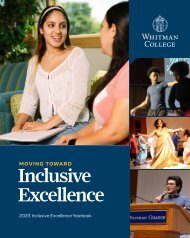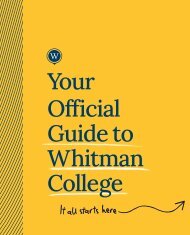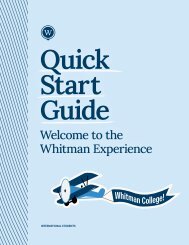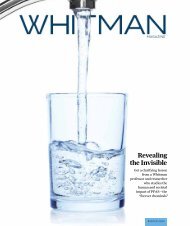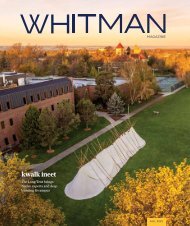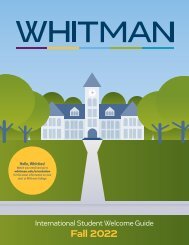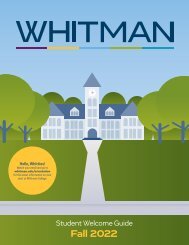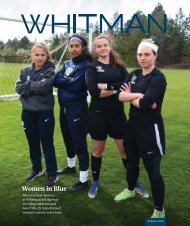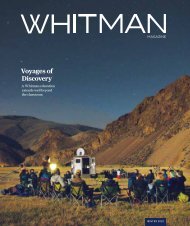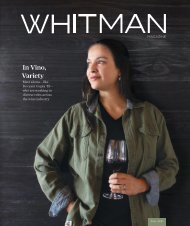Whitman College Undergraduate Conference Program 2020
Whitman College 2020 Undergraduate Conference Program
Whitman College 2020 Undergraduate Conference Program
You also want an ePaper? Increase the reach of your titles
YUMPU automatically turns print PDFs into web optimized ePapers that Google loves.
SESSION 3<br />
the inherent reliance of the commons on the power of<br />
community also creates exclusion. My research is an<br />
attempt to better integrate equitable structures of inclusion<br />
into the commons and, in so doing, help it survive as an<br />
aspirational post-capitalist political economy.<br />
Faculty Sponsor: Susanne Beechey<br />
4 p.m. GRACE DUBLIN, <strong>Whitman</strong> <strong>College</strong> and the<br />
Washington State Penitentiary<br />
The Washington State Penitentiary and <strong>Whitman</strong> <strong>College</strong><br />
are only 2 miles apart, yet the interactions between these<br />
two cornerstones of the Walla Walla community in 130<br />
years of co-existence are limited. Why is it that these two<br />
institutions don’t interact more frequently in meaningful,<br />
mutually beneficial ways? In my presentation, I explore<br />
the historical relationship between these two institutions<br />
in order to examine the nature and the purpose of<br />
their interactions and the benefits and risks of this<br />
relationship. I also speculate about why the relationship<br />
hasn’t expanded over time. Finally, I hope to illustrate<br />
the many benefits that might result from colleges and<br />
prisons creatively and thoughtfully working together in a<br />
symbiotic, less institutional way.<br />
Faculty Sponsor: Keith Farrington<br />
Philosophy: Tradition<br />
and Adaptation<br />
OLIN 129<br />
Mika Nevo, moderator<br />
Jamie Gold, coach<br />
3 p.m. SUNSHINE ALVAREZ DE SILVA, Could We Rest?<br />
In “Avengers: Endgame,” before risking all that he holds<br />
dear, Tony Stark is asked by Pepper Potts if he could rest if<br />
he doesn’t do what he thinks is right. In Plato’s “Apology,”<br />
Socrates raises a potential question that he imagines the<br />
jury and audience at his trial could pose to him: Is he not<br />
ashamed of engaging in a practice that puts his life at risk?<br />
To this hypothetical question, Socrates replies that one<br />
should not consider the risk of life or death but rather if the<br />
action that one carries out is just or not, the work of a good<br />
man or a bad man. These two questions and the actions<br />
taken to address them, resonate with each other. What<br />
does this mean? Should we consider Socrates’ answer as<br />
the right one? Could we rest if we didn’t do the work of<br />
good people?<br />
Faculty Sponsor: Kate Shea<br />
3:15 p.m. ANDREAS GUERRERO, The Philosophy of<br />
Caroline of Ansbach<br />
Caroline of Ansbach was a British monarch at the start<br />
of the 18th century. She was called the “Champion of<br />
Protestantism,” worked with Robert Walpole to govern<br />
the British Empire and was praised by Voltaire. Though<br />
she never authored a philosophical treatise, she argued<br />
with Newton and Leibniz, coordinated and commented on<br />
philosophical correspondence and ruled in a manner that<br />
indicates a distinct, progressive political philosophy. She<br />
also supervised the construction of two garden exhibits<br />
that reveal her philosophical persuasions. Despite these<br />
accomplishments, Caroline’s philosophy remains largely<br />
uninvestigated. Utilizing the strategy of American-<br />
Canadian philosopher Lisa Shapiro to diversify the canon,<br />
I hope to fill this gap in the history of philosophy by<br />
examining Caroline’s life and deeds. My presentation is the<br />
product of collaborative research and will shed light on one<br />
of the most interesting women of the 18th century.<br />
Faculty Sponsor: Patrick Frierson<br />
3:30 p.m. DANA WALDEN, Miranda Fricker and<br />
Testimonial Vulnerability<br />
Philosopher Miranda Fricker introduced the concept of<br />
testimonial injustice, or the dehumanization that occurs<br />
when a person is disbelieved and dismissed because of her<br />
identity. From this understanding of testimonial injustice,<br />
I propose in my presentation the idea of testimonial<br />
vulnerability, which can have equally devastating effects<br />
on the individual as well as the epistemic community.<br />
Vulnerability is typically defined as exposure to the<br />
possibility of harm. Testimonial vulnerability, then, can be<br />
understood as one’s exposure to the possibility of epistemic<br />
or testimonial harm, with the additional possibility that the<br />
vulnerability itself can be experienced as a harm. I argue<br />
that the mere possibility of this harm is, in itself, an injustice<br />
insofar as testimonially vulnerable people are subject to<br />
silencing and exclusion from the community of knowers.<br />
Faculty Sponsor: Rebecca Hanrahan<br />
3:45 p.m. FAYE LIU, On Miracles, Hume and Sor Juana<br />
David Hume, in “Of Miracles,” delineates several defenses<br />
against proofs of miracles. One of his contentions is<br />
that miracles are “a violation of the laws of nature.” Sor<br />
Juana’s poem, “First Dream,” ends with a depiction of<br />
the sun overcoming night as she awakes. (“. . . the World<br />
illuminated and I awake.”) The poem serves as a challenge<br />
to Hume’s ideas on miracles. Taking a phenomenological<br />
approach, Sor Juana situates the shifts and movements<br />
within her dream (her unconscious). In my presentation,<br />
I explore miracles in the context of epistemology and<br />
political analysis. What does it mean to “demand<br />
the impossible?”<br />
Faculty Sponsor: Patrick Frierson<br />
4 p.m. MIKA NEVO, Hume and Sor Juana on Miracles and<br />
Unlikely Realities<br />
Hume’s definition of miracles establishes them as<br />
inherently impossible. He argues that any encounter<br />
with an event that is perceived to be miraculous should<br />
be rejected on the grounds that it is contradictory to<br />
logic and probability. Such an approach to events that<br />
challenge our previously held belief systems poses<br />
a serious threat to discoveries and progress. In her<br />
own search for understanding, Sor Juana repeatedly<br />
encounters things that are incomprehensible to her. Her<br />
construction of knowledge is grounded in reason but<br />
allows the imagination to challenge presuppositions. Sor<br />
Juana’s approach to the incomprehensibility of the world<br />
serves as a useful model for pursuing new knowledge. It<br />
also reminds us that our understanding of the world is<br />
constantly changing and ever expanding. Advancements<br />
to our understanding of the world depend on the ability to<br />
imagine the inconceivable.<br />
Faculty Sponsor: Patrick Frierson<br />
Bio II: Genes and Phenotypes<br />
SCIENCE 159<br />
Abbey Felley, moderator<br />
Alex Brockman, coach<br />
3 p.m. MADELINE BOYLE, Genetic Mechanisms of a New<br />
Phenotype in the Genus Mimulus<br />
The genus Mimulus includes plants that produce a wide<br />
array of pigments in their flowers. Previous research has<br />
shown that some species of Mimulus produce similar<br />
pigments to each other yet use different mechanisms.<br />
Comparing these mechanisms may shed light on how<br />
evolution fundamentally works. Mimulus naiandinus<br />
produces pink flowers using the pigment anthocyanin.<br />
Prior studies identified the Myb3a anthocyanin gene<br />
as a prominent contributor affecting flower pigment in<br />
M. naiandinus. A RNAi transgene was constructed in<br />
order to knock down Myb3a in M. naiandinus and observe<br />
what effects the transgene had on pigment expression.<br />
Results suggest that Myb3a does significantly affect color<br />
pigmentation in the flowers of M. naiandinus.<br />
Faculty Sponsor: Arielle Cooley<br />
3:15 p.m. ELLEN HOM, Repeated Evolution of Petal Lobe<br />
Anthocyanin in Mimulus: Functional Tests of a Candidate Gene<br />
Three species of Chilean Mimulus have independently<br />
evolved anthocyanins, pigments that cause red coloration<br />
in flower petals. This event is known as repeated evolution.<br />
I hope to determine whether Myb5, an anthocyaninactivating<br />
transcription factor gene, is sufficient to trigger<br />
petal pigmentation. I hypothesize that if overexpressing<br />
Myb5 induces petal lobe anthocyanins, then Myb5 is<br />
most likely sufficient for anthocyanin pigmentation.<br />
To this end, I have infiltrated an overexpression vector<br />
containing the Myb5 gene into yellow-flowered Mimulus<br />
cupreus in order to produce transgenic seeds for study.<br />
I am also investigating two sequence variants found<br />
between genomic DNA and mRNA in Mimulus luteus var.<br />
variegatus and I have found that the variants seem to be<br />
the result of a post-transcriptional modification. Exploring<br />
the importance of these variants and repeated evolution<br />
in Mimulus creates an opportunity to study the molecular<br />
mechanisms of evolution.<br />
Faculty Sponsor: Arielle Cooley<br />
3:30 p.m. JACK TAYLOR, OWEN DAVIS-BOWER, ABBEY<br />
FELLEY, Data Analysis of Hybrid Monkeyflower Petal Images<br />
Hybrid monkeyflowers (Mimulus) have yellow petals<br />
with randomly dispersed red spots. In order to better<br />
understand these spotting patterns, we utilized computer<br />
vision techniques to collect various data on images of<br />
hybrid monkeyflower petals. In our presentation, we<br />
explain our applications of Euclidean transformation<br />
estimation, enhanced correlation coefficient maximization<br />
and several other image processing techniques to identify<br />
characteristics such as vein density and to decompose<br />
clusters of overlapping spots into individual spots. We<br />
will then demonstrate the system that we designed and<br />
highlight its uses.<br />
Faculty Sponsor: John Stratton<br />
36 37



